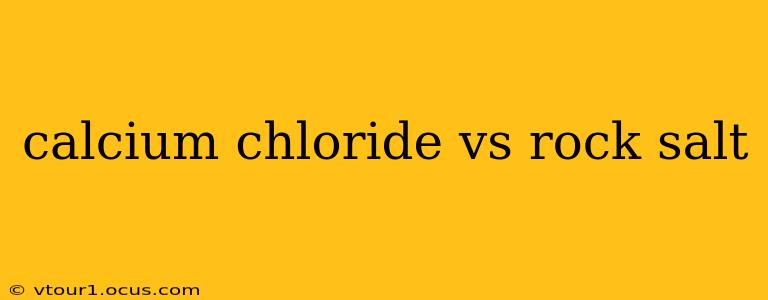Winter's icy grip can bring roads and walkways to a standstill, making de-icing a crucial task for homeowners and municipalities alike. Two popular choices for melting ice and snow are calcium chloride and rock salt (sodium chloride). While both effectively lower the freezing point of water, there are significant differences in their performance, environmental impact, and cost. This comprehensive guide will help you understand the key distinctions and determine which de-icer best suits your needs.
What is Calcium Chloride?
Calcium chloride (CaCl₂) is a chemical compound that, when dissolved in water, releases heat – an exothermic reaction. This heat generation contributes to its superior ice-melting capabilities, particularly at lower temperatures. It’s also more effective in wet conditions than rock salt. Calcium chloride is available in various forms, including flakes, pellets, and liquid solutions.
What is Rock Salt (Sodium Chloride)?
Rock salt, or sodium chloride (NaCl), is the common table salt we use in our kitchens, but in a coarser, less refined form. It’s widely available, relatively inexpensive, and effective at melting ice above 20°F (-7°C). However, its effectiveness diminishes significantly at lower temperatures.
Calcium Chloride vs. Rock Salt: A Head-to-Head Comparison
This section directly addresses the key differences between these two popular de-icing agents.
Melting Temperature:
- Calcium Chloride: Melts ice at significantly lower temperatures than rock salt, often down to -25°F (-32°C) depending on the concentration. Its heat-generating properties make it ideal for severe winter conditions.
- Rock Salt: Generally effective down to around 20°F (-7°C). Below this temperature, its effectiveness drastically reduces.
Effectiveness in Wet Conditions:
- Calcium Chloride: Highly effective in wet conditions because it absorbs moisture from the air, helping it dissolve and work more quickly.
- Rock Salt: Less effective in wet conditions; it requires direct contact with the ice to work.
Environmental Impact:
- Calcium Chloride: While less harmful than some other de-icers, it can still have negative environmental consequences. It can damage vegetation and contribute to soil salinity if used excessively.
- Rock Salt: Rock salt is known to harm vegetation, corrode concrete and metal, and pollute waterways through runoff. Its impact is generally considered more significant than calcium chloride's.
Cost:
- Calcium Chloride: Generally more expensive than rock salt.
- Rock Salt: Significantly cheaper than calcium chloride, making it an economically attractive option for large-scale use.
Corrosion:
- Calcium Chloride: While less corrosive than rock salt, it can still contribute to corrosion of some metals.
- Rock Salt: Known for its corrosive properties on metal and concrete, potentially damaging vehicles, infrastructure, and walkways.
Pet and Plant Safety:
- Calcium Chloride: Both calcium chloride and rock salt can irritate pets' paws and cause stomach upset if ingested. Both can also damage plants and lawns.
- Rock Salt: Similar risks to pets and plants as calcium chloride.
Which De-icer Should You Choose?
The best choice depends on your specific circumstances:
- For extreme cold temperatures (-25°F or lower): Calcium chloride is the clear winner due to its effectiveness at low temperatures.
- For milder temperatures (above 20°F): Rock salt is a cost-effective option.
- For environmentally sensitive areas: Consider using alternative de-icers or sand for traction. Reduce the usage of both calcium chloride and rock salt to minimize environmental impact.
- For large areas (roads, parking lots): Rock salt's affordability makes it economically viable for larger areas, although its environmental impact should be carefully considered.
Remember to always follow the manufacturer's instructions for safe and effective application.
Frequently Asked Questions (Based on "People Also Ask" sections)
Is calcium chloride better than rock salt for driveways?
It depends on the climate and your priorities. Calcium chloride is superior in extremely cold temperatures and wet conditions but is more expensive. Rock salt is cheaper but less effective in cold and wet conditions. Consider the average winter temperature in your region to make an informed decision.
Is calcium chloride harmful to pets?
Yes, both calcium chloride and rock salt can irritate pets’ paws and cause stomach upset if ingested. Keep pets off treated areas until the de-icer has been washed away, and consider pet-safe alternatives if possible.
Is calcium chloride bad for the environment?
While less harmful than some other de-icers, calcium chloride can still negatively affect the environment if overused. Excessive use can lead to soil salinity and damage vegetation. Responsible application and consideration of alternatives are crucial for minimizing environmental impact.
What is the safest de-icer for pets and plants?
There is no completely "safe" de-icer for pets and plants. However, sand or kitty litter provide good traction without the chemical risks. If using chemical de-icers, careful application and quick removal are recommended to minimize the risk.
Does calcium chloride melt ice faster than rock salt?
Generally, yes. Calcium chloride's exothermic reaction generates heat, helping it melt ice more quickly, especially in colder temperatures. The speed of melting also depends on factors like ice thickness and application method.
This information is for general knowledge and should not be considered professional advice. Always consult local regulations and guidelines regarding de-icer use.
